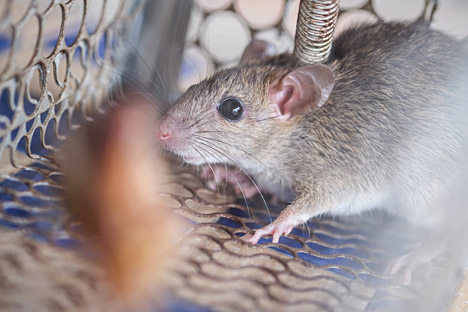Cyborg rodent army to the rescue

According to scientists, the rats' receptor neurons contain thousands of naturally renewable protein receptors that help them differentiate a larger quantity of smells than modern devices or even dogs. Source: Shutterstock/Legion Media
In a simulation of a scenario from sci-fi movies, scientists at the Perception and Recognition Neuro-technologies Laboratory at the South Federal University in Rostov-on-Don have planned to use the hypersensitive sense of smell in rats to detect explosive devices. These cyborats will be fitted with microchips in their brains and are likely to be more effective than dogs.
The scientists claim that the rats' receptor neurons contain thousands of naturally renewable protein receptors that help them differentiate a larger quantity of smells than modern devices or even dogs. And with this new technology implanted in them, the rodents' powers of recognition will be unprecedented.
The microchip will be able to monitor the animal's physiological reaction to a smell even when the concentration of the substance being sought is miniscule, even when the rodent itself has not reacted to the smell. The signal is transmitted to a computer, which is then picked up by law-enforcement.
Obstacles
The laboratory instrument consists at the moment of only a wire, and the activity radius is determined by the length of the wire, which is five metres long. These Cyborats in future will be able to inspect objects by themselves, penetrating even the most difficult places. At the outset, the system will comprise boxes with rats and wires, but scientists are facing challenges with this.
"The rat can gnaw and tear up the wires, so that is why today the animals are kept asleep during experiments," explained Dmitry Medvedev, the laboratory director. Another challenge facing scientists is understanding what occurs in the rat's brain when it senses a certain smell, and then determining the precise cerebral impulse that reacts to the explosive device. It is practically impossible to shield the cyborat from external stimulants in real-life conditions.
In Tanzania, Mozambique, Thailand, Angola and Cambodia, the African hamster rat is used to detect mines. In Columbia, laboratory rats are also employed for finding landmines. In the Netherlands, rats are used to detect traces of burned powder, while in Israel rats help the police inspect luggage in airports. Each case uses rats that are trained by fear and pain (for example, from shock), or with food. When they detect the desired smell they hide in a special hole, or stand on their hind legs.
Cyborat army
Three groups of specialists are simultaneously working on the project: physiologists are training the animals to recognize drugs and explosives; engineers are perfecting the instruments; and programmers are creating mathematical algorithms to study the results. These algorithms will help scientists gather data and statistics of the rats' cerebral reactions to various smells.
One animal can be trained to react only to one certain smell. An army of cyborats will thus be necessary because attrition rates will be high.
"Two to three months are needed to teach the animal to react to one substance while the lifespan of a laboratory rat is only about a year," said Medvedev. "We can't use very young rats, while the old ones have already lost their sense of smell."
Prospects
Scientists plan to complete the development of the system's biotechnical model by the middle of 2016.
The Russian Health Ministry and the Ministry of Emergency Situations have shown interest in the project. Rats are also capable of determining various illnesses based on smells, and often, in the very early stages when other methods still do not work, particularly diseases like tuberculosis and several types of cancers. Rats can also be used to search for victims in emergency situations. However, scientists say that it is wishful thinking that rats can be taught to distinguish the smell of a living person from that of a dead person in a limited time-frame.
All rights reserved by Rossiyskaya Gazeta.
Subscribe
to our newsletter!
Get the week's best stories straight to your inbox
